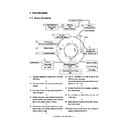Sharp AR-651 (serv.man7) Service Manual ▷ View online
AR-651/810 COPY PROCESS 3 - 5
• Developer material
The developer material is a mixture of toner and
carrier. The toner is charged to negative polarity and
the carrier to positive polarity, due to the friction with
each other caused by mixing.
Toner : Mainly consists of resin and carbon.
Carrier : Consists of ferrite and resin coating on its
surface to provide consistent frictional elec-
trification. (Charge controll)
Carbon
(5~10%)
(5~10%)
[Carrier]
Resin (90~95%)
[Toner]
5~20µm
30~100µm
Ferrite
Note:
If the developer material is used for a long time (be-
yond its normal life span),
the toner is caked onto the carrier.
훹
The carrier’s (charging) performance is lowered.
Symptom: 1. Image density is decreased.
2. Toner scattering occurs.
3. Background fogging occurs.
Solution:
Replace with new developer material.
Toner
Carrier
No frictional electrification
on the area where the toner
is caked on
on the area where the toner
is caked on
• Magnetic roller
- Magnetic brush development -
The south and north poles are arranged inside the
magnetic rollers, as shown in the right figure. This
causes the developer material to form a brush-like
fluff which contacts the photoconductive drum sur-
face.
훹
This is caused by the lines of magnetic force be-
tween the south and north poles.
Lines of
magnetic force
magnetic force
Magnetic roller
OPC drum
N
S
S
AR-651/810 COPY PROCESS 3 - 6
Additional Explanation
The life of the toner cartridge (number of copies) varies depending on the following conditions.
1. Coverage of originals (printing image ratio of the original size) and density of original background
2. Size and density of originals
3. The existence of solid black when making copies (when a book is copied and the original cover is
partially open)
4. Temperature and humidity in the room when making copies
5. Copy density and image quality mode
As indicated in the figure below, the life of the toner cartridge varies depending on the copy mode and
coverage of originals
Type of originals
A.
B.
C.
A
20,000
30,000
40,000
50,000
60,000
70,000
74,000
A
20,000
30,000
40,000
46,000
B
20,000
27,000
15,000
C
A
20,000
30,000
38,000
AR-651/810 COPY PROCESS 3 - 7
Combined use of transfer belt and
separation finger
To prevent the copy paper from failing to
be separated during the operation, due to
incomplete transfer belt charging or
absorption of moisture, and thus jamming
up the cleaner, a separation finger
mechanically separates any copy paper
which fails to be separated.
(6) Transfer/Separation
Transfer:
Transfer is a process of transferring the toner image
(visible image) formed on the drum surface onto the
paper.
An electric charge applied by the high voltage power
supply flows to the transfer belt from the power
supply roller. Then it flows to the paper and OPC
drum. The toner, which has been developed on the
drum's surface, is transferred to the paper by elec-
trostatic attraction.
Separation:
The paper is held to the belt and separated from the
drum by the electrostatic attraction acting between
the belt (plus charge) and the polarization charge
(minus charge) on the bottom surface of the paper.
Drum
Paper
Transfer
belt
belt
Rotation of drum
Transfer belt
Paper movement
Separation finger
Reference
•
Drum
E
Toner
Transfer belt
Power supply roller
Paper
Aluminum conductive base
OPC layer
AR-651/810 COPY PROCESS 3 - 8
(7) Fusing
Fusing is a process of melting and fixing the toner
on the paper.
Method : The melting point of the toner (main
ingredient: resin) is 100~110°C.
훹
(Heat)
The toner is melted by the heat of the
surface of the fuser roller.
+
(Pressure) The pressure roller is pressed against
the fuser roller by the springs to increase
adherence of the melted toner to the
paper.
훹
Heat and pressure are applied to the
paper when it passes between the fuser
roller and pressure roller.
||
(Fusing)
The toner is fixed on the paper.
Fuser roller
Paper
Pressure
Heat
IH coil
Fuser roller
Paper movement
Pressure
Separation finger
Pressure roller
(8) Cleaning
Cleaning is a process of recovering any residual toner
on the photoconductive drum.
1. The cleaning brush scrapes off any toner
and paper wastes. The flicker scrapes off any
toner on the brush.
Also, too prevent the cleaning blade from
scratching the surface of the drum to make a
circumferential streak, the varistor is attached
between the brush and earth.
2. Cleaning blade scrapes off any residual toner
from the drum.
3. The recovery blade picks up any falling toner.
Cleaning blade
Flicker
Recovery blade
Cleaning brush
Drum rotation
Click on the first or last page to see other AR-651 (serv.man7) service manuals if exist.

